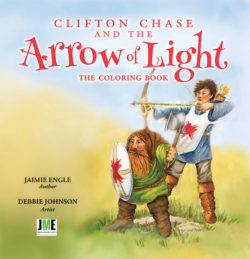Several years ago, I reviewed a book called Clifton Chase and the Arrow of Light by Jaimie Engle. Since then, I’ve been impressed with Jaimie’s passion to educate kids about standing up against bullying. Her book addresses the issue, but she doesn’t stop there. Jaimie also visits schools to speak about bullying and how to combat it. I asked her to share some of her insights with us here today.
Bullying: Standing Up
By Jaimie M. Engle
Students are burdened to identify themselves as aggressors, victims, passive bystanders or aggressive bystanders. According to the US Department of Education, more than 8 million students nationwide ages 12-18 reported being bullied.
As parents, how can we not encourage kids to confront these individuals? To passively walk away and hope the bully will leave them alone. What does this resolve? Won’t they just seek a new, weaker person to prey upon? It is our responsibility to teach the next generation to stand up for someone when they don’t have the words, courage, or ability to stand up for themselves.
The National Education Association reported that 160,000 bullied children miss at least one day of school a month. These children are more likely to experience mental health concerns resulting in issues such as head and stomachaches, inability to concentrate, poor performance in school, to the worst cases of depression, isolation and suicide. How can a child who is told to ignore a malicious statement possibly pay attention in class? Or a student who is threatened physical harm able to attend school when told to turn the other cheek?
When my son was in first grade, he was bullied and no one was there to help him. That’s why I wrote my first book. I grew up letting people push me around and I didn’t want to see my son make my same mistakes.
Bullying is not a new thing, and it doesn’t just occur between kids. In my book, Clifton Chase and the Arrow of Light, Clifton is dealing with the school bully and failing miserably until he is magically whisked away to Medieval England. There, he helps two forgotten princes face their tyrant uncle while being guided by a dwarf named Dane and a mythical creature called Simurgh. Through discovering the true meaning of friendship and the courage to do what’s right, Clifton discovers his purpose, rescues the princes, and faces his own bully.

With #everykidsvoice we can #targetbullying to stop it!
Visit Jaimie Engle on her web site to learn more about her books, school visits, and services to help authors.
Clifton Chase and the Arrow of LightClifton Chase couldn’t possibly know the mysterious arrow he finds in his closet will lead him to the year 1485. Two princes need his help, but why? Carrying the Arrow of Light, a weapon forged from the Tree of Knowledge itself, Clifton is led on a journey to face fire-breathing dragons, kidnapping by merpeople, and a final battle, which will end the War of the Roses and the reign of a tyrant king. Will Clifton discover his purpose on time and save the day? Or has the arrow chosen the wrong boy? History clashes with fantasy in this middle grade adventure story. (From Goodreads) Amazon | Barnes & Noble | Goodreads | Story Sanctuary Review |
Save
Save
Save